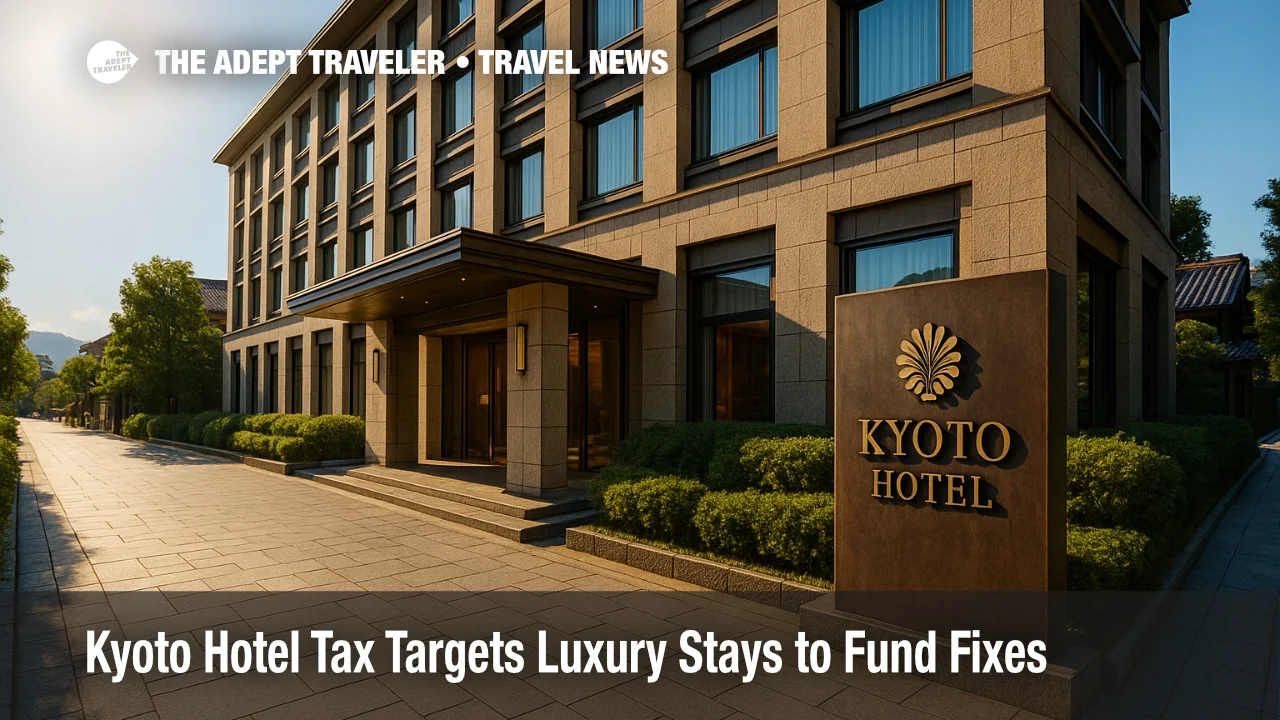Kyoto hotel tax targets luxury stays to fund fixes

Kyoto will sharply raise its accommodation tax on March 1, 2026, creating Japan's highest hotel levy and concentrating the biggest increases on luxury stays. The city says receipts will support congestion relief, cultural preservation, and public services strained by record visitor volumes. Budget travelers will see little change, while guests paying ¥100,000 or more per night will face a ¥10,000 tax per person, per night. Officials argue the tiered design aligns costs with ability to pay and directs new funding toward sustainable tourism measures.
Key points
- Why it matters: Kyoto gains a dedicated revenue stream to manage overtourism without blunt bans.
- Travel impact: Minimal for budget and midscale; steepest for luxury, suite, and villa stays.
- What's next: City departments will allocate funds to mobility, sanitation, and cultural-site upkeep.
- Tax tiers rise from ¥200 to as high as ¥10,000 per person, per night.
- Approval confirmed by Japan's Internal Affairs Ministry on October 3, 2025.
Snapshot
Kyoto's revised accommodation tax keeps the base rate of ¥200 for stays under ¥6,000, nudges the mid tiers to ¥400 and ¥1,000, then jumps to ¥4,000 for ¥50,000 to under ¥100,000 rooms, and ¥10,000 at ¥100,000 and above. The new structure replaces the current ¥200 to ¥1,000 ceiling introduced in 2018. The city received central-government sign-off on October 3, 2025, clearing implementation for March 1, 2026. Officials say revenue will fund transit pinch-points, crowd management around popular districts, and maintenance at heritage sites. Kyoto expects these measures to improve resident satisfaction and visitor experience, even as overall demand remains strong.
Background
Kyoto's visitor rebound has outpaced pre-pandemic norms, with luxury ADRs rising amid a weak yen and premium openings across Japan. The city's 2018 tax, capped at ¥1,000, generated steady income but proved too small to keep up with crowding and sanitation needs in peak seasons. Pressure mounted in 2024 and 2025 as marquee spots saw chokepoints and neighborhood friction. With parliament-style approval from the Kyoto City Assembly earlier in 2025 and final ministry consent in October, the city locked in a higher, more progressive levy. Kyoto's approach mirrors global trends in Venice, Amsterdam, and Scotland, yet it stops short of access caps by pricing externalities into the highest-end stays.
Latest developments
Kyoto approves a tiered accommodation tax up to ¥10,000
Kyoto formally published its ordinance revision, detailing five brackets tied to nightly room price before meals and consumption tax. Under ¥6,000 remains ¥200; ¥6,000 to under ¥20,000 becomes ¥400; ¥20,000 to under ¥50,000 is ¥1,000; ¥50,000 to under ¥100,000 is ¥4,000; and ¥100,000 and above is ¥10,000 per person, per night. The Internal Affairs Ministry granted consent on October 3, 2025, following the assembly's earlier vote. The city frames the move as ability-to-pay financing that preserves access for mainstream travelers while capturing meaningful funding from high-spend segments. Industry notices have begun advising guests that many booking sites show rates excluding local lodging taxes, so totals will adjust at checkout.
Analysis
Will this slow demand? Unlikely at the top end. Kyoto's luxury cohort books once-in-a-lifetime trips, peak-season ryokan suites, or branded residences where an added ¥10,000 per person, per night is incremental relative to five-figure itineraries. Price-insensitive travelers historically absorb city levies in Paris, Amsterdam, and Rome with limited impact on length of stay. By concentrating increases on premium inventory, Kyoto avoids penalizing students, families, or long-stay visitors who contribute to neighborhood economies. The design also reduces the need for hard caps that risk displacement to unprepared districts. The key execution risk is ring-fencing revenue for visible fixes: cleaner streets, better multilingual signage, first-mile and last-mile transit flows, and crowd-control staffing at hotspots. Transparent reporting will determine whether residents feel relief and travelers perceive value. For context, Japan's inbound surge and currency advantage continue to propel visitation, suggesting the tax will shape behavior at the margins rather than suppress a boom.
Related reading on Adept.Travel: Japan Travel Boom Could Top 40 Million Visitors in 2025 and Mount Fuji, Japan Tackles Overtourism and Litter Crisis.
Final thoughts
Kyoto has chosen a scalpel, not a sledgehammer, asking luxury guests to underwrite cleaner streets, smoother mobility, and preserved heritage without pricing out the mainstream. Expect little impact on occupancy at the top end and tangible upgrades if funds are deployed where friction is worst. For planners, factor the levy into total trip budgets and communicate clearly on pre-tax versus all-in rates. If the city delivers visible improvements, the policy could become a model for balancing growth and livability, proving the case for a well-designed Kyoto hotel tax.
Sources
- 令和8年3月1日からの宿泊税の見直しが正式決定, City of Kyoto
- 宿泊税について(税率改定の詳細), City of Kyoto
- Kyoto ordinance revision PDF, City of Kyoto
- Japan's Internal Affairs Ministry approves changes to Kyoto's accommodation tax, Traicy (EN)
- Kyoto to hit visitors with Japan's highest-ever hotel tax, Skift
- Japan's highest-ever hotel tax awaits tourists to Kyoto from March 2026, South China Morning Post
